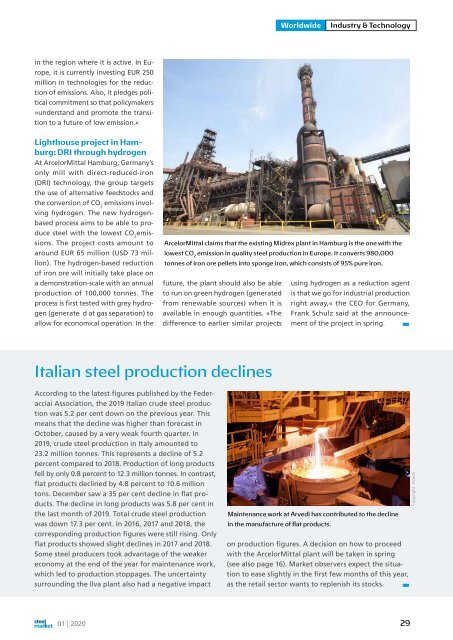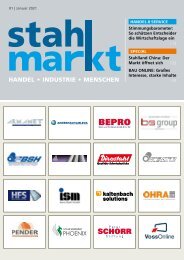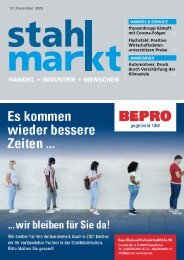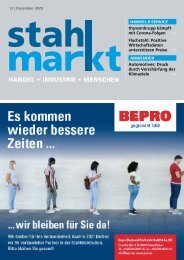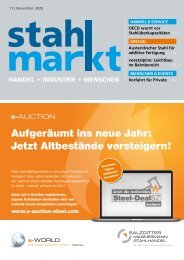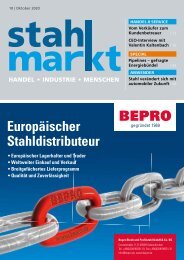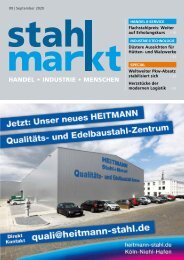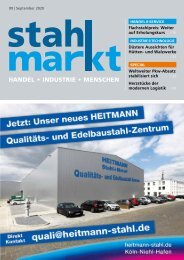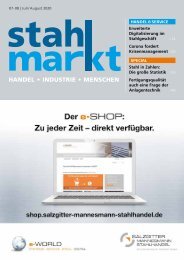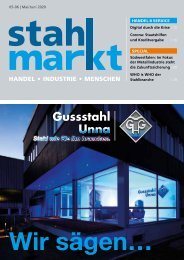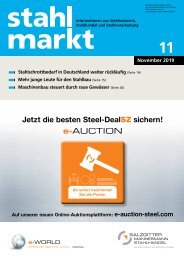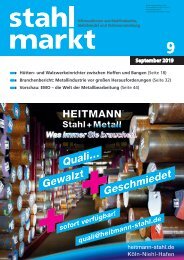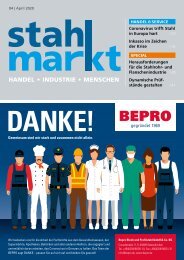Steel Market 01 / 2020
You also want an ePaper? Increase the reach of your titles
YUMPU automatically turns print PDFs into web optimized ePapers that Google loves.
Worldwide<br />
Industry & Technology<br />
in the region where it is active. In Europe,<br />
it is currently investing EUR 250<br />
million in technologies for the reduction<br />
of emissions. Also, it pledges political<br />
commitment so that policymakers<br />
»understand and promote the transition<br />
to a future of low emission.«<br />
Lighthouse project in Hamburg:<br />
DRI through hydrogen<br />
At ArcelorMittal Hamburg, Germany’s<br />
only mill with direct-reduced-iron<br />
(DRI) technology, the group targets<br />
the use of alternative feedstocks and<br />
the conversion of CO 2<br />
emissions involving<br />
hydrogen. The new hydrogen-<br />
based process aims to be able to produce<br />
steel with the lowest CO 2<br />
emis-<br />
sions. The project costs amount to<br />
around EUR 65 million (USD 73 mil-<br />
lion). The hydrogen-based reduction<br />
of iron ore will initially take place on<br />
a demonstration-scale with an annual<br />
production of 100,000 tonnes. The<br />
process is first tested with grey hydrogen<br />
(generate d at gas separation) to<br />
allow for economical operation. In the<br />
ArcelorMittal claims that the existing Midrex plant in Hamburg is the one with the<br />
lowest CO 2<br />
emission in quality steel production in Europe. It converts 980,000<br />
tonnes of iron ore pellets into sponge iron, which consists of 95% pure iron.<br />
future, the plant should also be able using hydrogen as a reduction agent<br />
to run on green hydrogen (generated is that we go for industrial production<br />
from renewable sources) when it is right away,« the CEO for Germany,<br />
available in enough quantities. »The Frank Schulz said at the announcement<br />
difference to earlier similar projects<br />
of the project in spring. •<br />
Italian steel production declines<br />
According to the latest figures published by the Federacciai<br />
Association, the 2<strong>01</strong>9 Italian crude steel production<br />
was 5.2 per cent down on the previous year. This<br />
means that the decline was higher than forecast in<br />
October, caused by a very weak fourth quarter. In<br />
2<strong>01</strong>9, crude steel production in Italy amounted to<br />
23.2 million tonnes. This represents a decline of 5.2<br />
percent compared to 2<strong>01</strong>8. Production of long products<br />
fell by only 0.8 percent to 12.3 million tonnes. In contrast,<br />
flat products declined by 4.8 percent to 10.6 million<br />
tons. December saw a 35 per cent decline in flat products.<br />
The decline in long products was 5.8 per cent in<br />
the last month of 2<strong>01</strong>9. Total crude steel production<br />
was down 17.3 per cent. In 2<strong>01</strong>6, 2<strong>01</strong>7 and 2<strong>01</strong>8, the<br />
corresponding production figures were still rising. Only<br />
flat products showed slight declines in 2<strong>01</strong>7 and 2<strong>01</strong>8.<br />
Some steel producers took advantage of the weaker<br />
economy at the end of the year for maintenance work,<br />
which led to production stoppages. The uncertainty<br />
surrounding the Ilva plant also had a negative impact<br />
Maintenance work at Arvedi has contributed to the decline<br />
in the manufacture of flat products.<br />
on production figures. A decision on how to proceed<br />
with the ArcelorMittal plant will be taken in spring<br />
(see also page 16). <strong>Market</strong> observers expect the situation<br />
to ease slightly in the first few months of this year,<br />
as the retail sector wants to replenish its stocks. •<br />
Copyright: Arvedi<br />
<strong>01</strong> | <strong>2020</strong> 29


